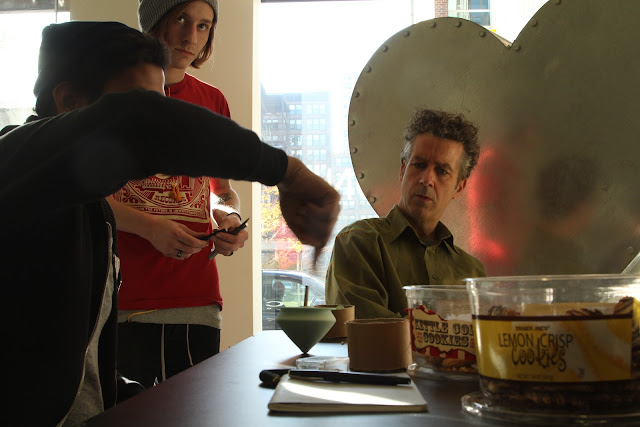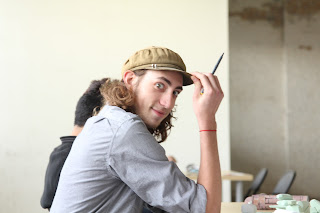Friday, October 26, 2012
Monday, October 22, 2012
Columbia and Marbles Play Parties
We've put the games "on the road"! Its been so great to share our games with all of you, please continue to give us your thoughts, we appreciate it so much! The first play party began at Columbia College, students and faculty of the Art + Design Department came through and enjoyed an assortment of cookies as they played with the games and toys we have been working on.
Then, the next official Play Party commenced at Marbles' headquarters in Chicago! Check out the fun in these photos, thank you so much for checking out what we're designing, we had a blast!
Then, the next official Play Party commenced at Marbles' headquarters in Chicago! Check out the fun in these photos, thank you so much for checking out what we're designing, we had a blast!
Videos to come soon!!
SOLITAIRE CUBES - Brochure & Instructions
The strategy of the game at this point is played exactly like the original Solitaire. Cubes are stacked 5 x 5, and all remaining cubes are blindly placed into the tower, where they will be drawn one by one from the bottom.
Sunday, October 21, 2012
Saturday, October 13, 2012
Building Phase Two
Getting ready for the "Play Party" on Monday! Here is one version of the Solitaire Blocks in progress...
Monday, October 1, 2012
Our First Week of Concepts
The first round of developing concepts, rough models and budding ideas!
Many of these concepts are pursuing the genre of "fidget toys" men and women can use at their desk or at home with friends. The idea of a fidget toy is to provide the mind another thing to focus on while they work through problems, brainstorming or any other activity. The toys should be interesting enough to capture the imagination, inspire interest while being subtle enough in order to not create too much distractions.
Here they are!
Concept 1.
This game is inspired from Dice and the game "Fifteen." The goal is to create combinations of the number six on each side. The challenge lies in the 3D aspect of the arrangement of the cubes. Not every cube will allow for the permutations!
Concept 2.
Think about origami for a moment...what if the paper you used was reusable like your own clothes? You would never run out of things to do with this toy, because once you create a origami, you can pull it apart and start a new one! A great element of fidget toys is the ability to automatically return to the "home state."
Concept 3.
Inspired off the game "Fiddlestix," this set of cubes uses blocks under tension with a stretchy string passing through each cube. Each side of the block has different patterns that can combine into exciting designs and aesthetically pleasing imagery.
Concept 4.
Using colored wooden beads on a posable wire, this game works much like the PlayableART ball (http://www.beyond123.com/playableart.html). The length of the beaded wire allows the toy to be bound and knotted, which causes interesting fidgeting.
Concept 5.
With a magnetic core, this game uses a cube made up of smaller wooden cubes, 3x3. Each wooden cube is embedded with a metal wire. Each wire runs through the cubes in different ways, some curving through, cutting directly through top to bottom or through all four sides. This will cause the cubes to connect in only certain ways, leaving some of the cubes to not connect together. This game allows for fidgeting through creativity and magnets that fight back like the Ball of Whacks (http://www.marblesthebrainstore.com/ball-of-whacks-red/).
This game works much like "Q-Bitz" (http://www.marblesthebrainstore.com/q-bitz/) where each player gets a stack of pyramids. A card is drawn with a four-sided pattern. The challenge is to match the 3D the patterns by stacking the pyramids. Each pyramid will attach magnetically to others, which will keep them from falling on each other. The first player who matches the pattern, wins and a new card is drawn. This came could be played solo, using the patterns as an interesting challenge.
Concept 7.
Imagine if Solitaire was played in 3D. No longer would we be playing with cards, but we would stack blocks like we did as a child. Each backside of the card-blocks will be a different random color, creating exciting patterns that can be played with by themselves. This game is inspired from playing with mahjong pieces and domino tiles like blocks. There could be much room for development in how the blocks are played with.
Concept 8.
Concept 9.
If origami could be indestructible, it could be more fun to continually play with. Also, if origami could instruct you in which way it wants to fold, it may require less focus and be more subconscious. Fidget toys are most often defined by their ability to unconsciously channel the brain through movement. This game is a sheet of indestructible paper that has triangular folds imbedded into it. Each triangle would be stiff, and have magnets embedded into the surface, allowing for the piece to form into many different shapes, as well as easily attach to other pieces.
Subscribe to:
Comments (Atom)


















































